The use of a borrowed cantus firmus as the basis for a composition has played an important role in our western musical tradition, both in the development of musical composition and in the pedagogy of counterpoint. One of the manifestations of this compositional practice is the use of a chorale or chant in organ music. While many types or classifications of such compositions exist, and while many of these are concerned with one or more types of contrapuntal "devices," this article focuses on some twentieth-century organ works (especially chorale preludes or chorale variations) in which the cantus firmus itself, in a relatively unornamented manner, is used in canonic form, in two or more voices.
An analytical approach applicable to the type of twentieth-century counterpoint encountered in the literature selected for this study is presented in the ensuing commentary. As a resource aid, the appendix to this article is a list of the compositions selected, arranged alphabetically by title of the cantus. The appendix also includes examples of compositions containing a cantus firmus in canon from the "traditional" harmonic period of the seventeenth-eighteenth centuries and examples having the more chromatic harmonic style of the nineteenth century.
From the sixteenth through the nineteenth centuries, the employment of a cantus firmus in canonic form was rather severely limited due to the restraints of preferred non-harmonic tone treatment and of accepted voice-leading principles. In the twentieth century, however, as these constraints are no longer as strongly observed by composers employing a cantus firmus, a larger percentage of canonic compositions are based on a cantus firmus, so that at one or more points the composer uses the complete cantus in two or more voices at the same time. Assuming that traditional non-harmonic usage and voice-leading principles are no longer a limiting factor in such canonic combinations, two questions arise: (1) Is there some characteristic that generally holds true regarding the relationship of the voices involved in the canon? (2) If so, does this influence the activity of the other voice(s) not participating in the canon?
To focus on the initial question, let us first consider a composition employing two voices only (see Example 1).
Ex. 1. Willy Burkhard, "Aus tiefer Not," Op. 281, Var. I.
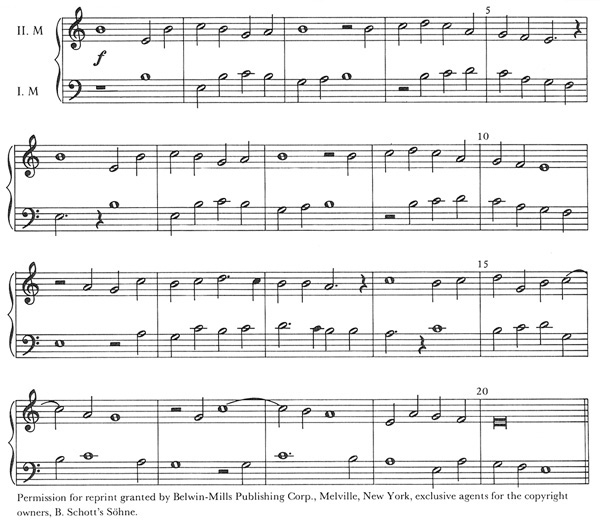
In this variation, the cantus is set, practically unmodified, in the two voices, one octave apart, at a time distance of two beats in 4/2 meter. That the resulting counterpoint is not "traditional" is readily apparent by such events as the perfect fourth which is the first harmonic interval, the treatment of the seventh in measure two, the parallel fifths between measures four and five, the parallel sevenths in measure thirteen, or the treatment of the suspension-like figure on beat one of measure sixteen. The resulting sound of this little variation is nevertheless comparatively "mild," obviously as a result of the conjunct nature of the melody. One important factor contributing to this sense of conjunctivity is the fact that in chorale tunes there are relatively few leaps. When they do occur, therefore, the event acquires considerable importance and the placement of the leaps merits attention. Since we are concerned here with employment of the tune in two voices, consider the temporal relationship of the appearances of leaps in the respective voices. Disregarding for the moment "dead" intervals at the points of rest between phrases, it will be seen that at no time do both voices have simultaneous leaps. In measure eleven, if the lower line is continued through the rest, notice that the resulting simultaneous leaps are to a "traditionally" consonant interval, in this case a tenth. Is this phenomenon inevitable under any circumstance? Consider the following:
Ex. 2. First phrase of "Aus tiefer Not."
Imitation at the fifth below, after four beats.

While the choice of time and pitch interval of the second voice in a canonic pairing would seem to be free and up to the discretion of twentieth-century composers, at least one that was rejected in this case is that shown in Example 2. Had the imitation occurred at the fifth below after four beats, there would be simultaneous leaps to a dissonant seventh in the second measure (*).
Another interesting point is the composer's setting of the fourth phrase. For the first time there is an alteration of the rhythm of the cantus firmus as compared to the chorale setting with which the work began.1 Keeping the note values consistent with those in the chorale theme, the result for phrase four would have been:
Ex. 3. Fourth phrase of "Aus tiefer Not."
Imitation at the octave below, after two beats.

On beat three of measure sixteen, the composer would have had both voices again leaping to a seventh (*). The rhythmic modification he employed eliminates the simultaneous leaps to the dissonant interval. This is not to imply that simultaneous leaps during a phrase are always avoided.
Example 4 gives the canonic voices at the beginning of variation nine of the Burkhard work:
Ex. 4. "Aus tiefer Not, " Var. IX, soprano and bass of mm. 1-7.

Here we find imitation by inversion after two bars. From bar three to four there are simultaneous leaps, but now to a traditionally consonant interval, as was the case in measure eleven of the first variation, if one disregarded the rest.
The resulting contrapuntal phenomenon, influenced both by the conjunct melodic nature of the cantus and by the traditional attitude towards consonance and dissonance, is: any harmonic relationship between two voices is acceptable except one where the lines contain simultaneous leaps to a traditionally dissonant harmonic interval.2
This statement is close to expressing, in an "opposite" manner, an analytical procedure first suggested by Charles Warren Fox as follows: (1) Consider what is happening at any one moment in the music. (2) Place brackets around all notes which are approached by a step of a minor or major second. (3) Place brackets around all notes which have been prepared as suspensions, or, possibly, as pedal points. (4) Any "unbracketed" notes remaining will, in practically every instance, form a chord structure no more complicated than a triad.3
Fox first applies this procedure to the contrapuntal art of the Renaissance to illustrate two methods of introducing dissonance: i.e., stepwise motion, and preparation by common tone. To apply the concept to twentieth-century polyphony, he then suggests an extension of it, so that preparation by stepwise motion may include diatonic or chromatic motion, a (melodic) seventh may represent a step, and stepwise motion need no longer appear as part of one of the "classical formulae" of non-harmonic tones. The point is then made that in selected twentieth-century compositions it is possible to "justify" the use of all of the notes (as the notes appear in a wide variety of harmonic combinations) on the basis of employing the four-step analytical procedure in conjunction with the concept of "extended" preparation. Thus, at any given moment, a note may be considered to be prepared as long as it is retained (or reiterated) or as long as it is approached by step (thereby being a bracketed note in the analytical procedure suggested by Fox). It also means that a leap in only one voice at any given moment is acceptable, since the retained or stepwise motion in other parts would satisfy the concept of preparation. It takes two (or more) voices leaping simultaneously to produce a sonority lacking preparation. Such a sonority, however, is still acceptable if it is a triad. Triads, of course, contain all the traditionally consonant intervals. It is at this point, therefore, that it occurred to the present author that, as one seeks to discover whether the analytical procedure will apply to a given composition, it would be more efficient simply to look for examples of simultaneous leaps to dissonant intervals. If no examples (or perhaps only one or two) occur, the principle of extended preparation is valid for that composition. Compositions which do reflect adherence to the principle tend to have a contrapuntal texture, with a relatively stable number of voice parts which maintain independence through carefully controlled rhythmic activity.
One further "extension of preparation" suggested by Fox is that a series of notes such as a figure, a motive, or even a theme or a subject can be considered a "preparation" of further statements of that melodic idea. On this basis, all canons in which the follower starts at some time interval after the leader could be said to satisfy the concept of extended preparation. Thus any resulting harmonic combination between the canonic voices (or between the "follower" in the canon and another accompanying voice) is valid. However, in the compositions selected for this study, it was found that in the vast majority of cases the relationship between the voices involved in the canon was limited to that of avoiding simultaneous leaps to a dissonance.
The definition of "dissonance" in twentieth-century context may present a slight problem. We probably can agree that unisons, thirds, perfect fifths, sixths, and octaves are consonant intervals; seconds, tritones, and sevenths are dissonant. The perfect fourth is justified as a consonance by Fox on the basis of being a dyad contained within a triad. The reader interested in applying the analytical procedure may decide for himself first which way to proceed (i.e., the four-step Fox method, or the search for simultaneous leaps to a dissonance) and may also decide to declare the perfect fourth either always a dissonance or always a consonance, or may reserve judgment and try to relate each case to its particular context. In this study, the perfect fourth has been accepted as a consonance. Admittedly it has been done so rather reluctantly, but compared to simultaneous leaps to seconds or sevenths, leaps to the perfect fourth seem to occur enough to warrant its consonant classification, and often the context does suggest a further justification. For instance, back in Example 1 the first simultaneity is a perfect fourth, which, while being accepted as a consonance for this study, also shows contextual justification since the imitation is at the octave, meaning that the pitch class b with which the lower voice begins has been "prepared" by already sounding for two beats in the upper part. Also, by way of review, notice again that while Example 1 contains digressions from traditional voice-leading and non-harmonic treatment, all the notes in the variation are "justifiable" on the basis of the extended preparation principle.
Example 5 is included to show two other ways in which simultaneous leaps might be justified. It also calls attention to one other instance of only two-voice texture, even though in this case the cantus does contain a fair amount of melodic elaboration.4
Ex. 5. Flor Peeters, Partita on "Veni Creator Spiritus," Andantino.
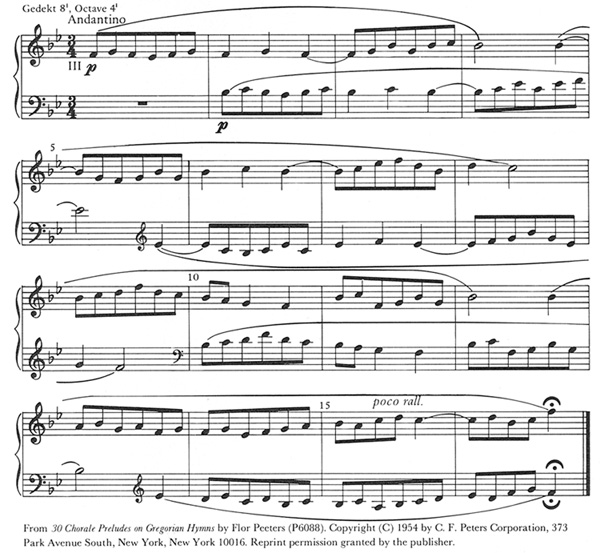
In Example 5, the imitation occurs after three beats, at the fifth below. On beat three of measure thirteen there is a major second approached by simultaneous leaps. On beats two and three of the upper voice, however, the cantus notes are the g and the f, with the off-beat eighths being melodic embellishments. Had the off-beat eighths not been inserted, the f would have had stepwise preparation from the g; moreover, the stepwise line occurring on the beats (a - g - f) is still very prominent, and the sense of "preparation" is convincing.
On beat two of measure sixteen a perfect fourth is approached by simultaneous leaps. This case may be contextually justified by the fact that the two pitches preceding the perfect fourth supply the "missing" note of the triad implied by the fourth (B-flat major), thus suggesting some sense of preparation. This type of situation (i.e., shared triadic members in leaps to a fourth) does occasionally occur. The principle of extended preparation and the analytical procedure of looking for simultaneous leaps to a dissonance has been presented regarding two-voice texture. Let us now move on to consider textures of three or more voices.
Example 6 shows the cantus "Vater unser" in canon at the octave below, after two beats, in the outer voices of the three-voice texture.
Ex. 6. Piet Post, Partita over het "Gebed des Heren" (1956), Var. 6.
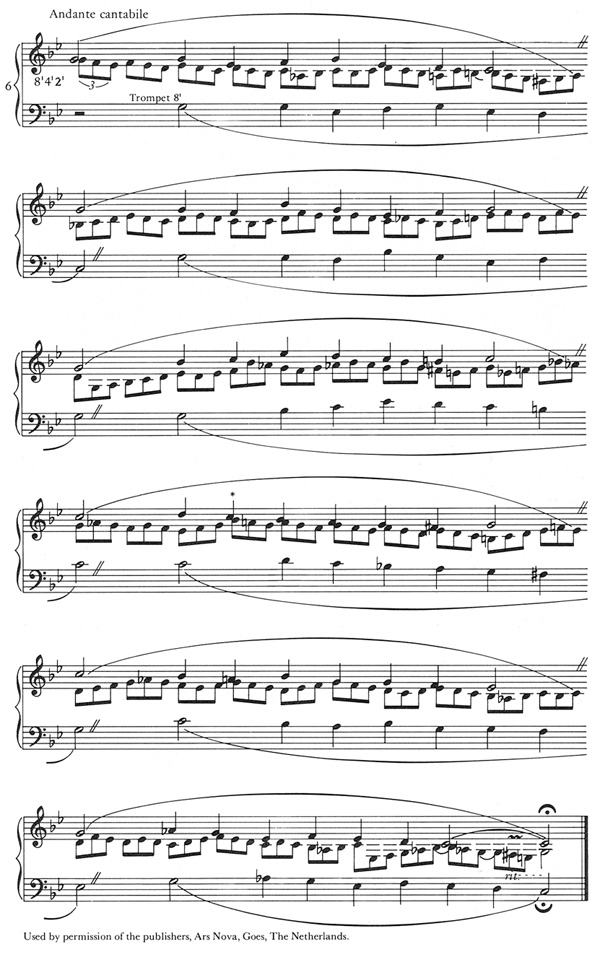
There are simultaneous leaps in the outer parts in the second and third phrases, but these are each to the perfect fourth (thus accepted as consonant). Otherwise, there are no simultaneous leaps in the canonic voices. Our interest focuses now on the added voice. Many digressions from "traditional" voice-leading and non-harmonic practices are evident. On the other hand, this added line, obviously influenced by the nature of chorale melodies, is practically all stepwise. A few leaps occur within beats, but the outer parts at those instances are sustaining quarter-notes, so that any leap would be acceptable within the suggested analytical procedure, since only one voice has motion at the given instant. A leap into a beat occurs at only one point in this middle, added part, at the fourth quarter-note beat of the fourth score (*). The top voice has stepwise motion at this point and the lowest voice is a sustained c; hence the inner part is free to leap, as the other two voices each exhibit an example of the extended preparation principle.
This example leads to the generality, then, that the principle seen to be governing the relationship between the canonic voices is also applicable to the accompanying, non-canonic voices and holds true in the vast majority of cases considered in this study.
In textures of three or more voices, there were obviously some cases where two (or occasionally more than two) voices did leap to a dissonant combination. In some instances, contextual justification such as a note being part of a particular chord, or part of a "prepared" melodic motive, or suggesting a common non-harmonic device or doubling a note already present is possible (Examples 7 and 9 serve as illustrations). In others, the situation just seems to be an exception to the general principle (see Example 8).
In Example 7, the bass voice imitates the soprano after two beats. There is a seventh on beat four of measure five (*). The a in the top voice, entering after the rest, is still the same note that preceded the rest, thus having preparation. Further, the inner line in measure five is imitating the preceding phrase of the cantus; therefore, the leap to b-natural occurs as part of a prepared melodic motive. On beat three of measure six, the harmonic seventh in the outer parts has been approached by simultaneous leaps (**). A contextual justification is that a tertian sonority still results, remaining harmonically consistent with the rest of the variation. However, the bass note g at the point of the seventh, changing the level of imitation from the twelfth to the eleventh, probably was used because the composer wished to avoid the parallel octaves which would have occurred. This is unusual, however, in that there were more examples found in this study of instances of "traditionally forbidden" parallelism than there were exceptions to the extended preparation principle. This particular seventh, however, does illustrate the simultaneous leaps with contextual justification (other than motivic preparation).
Ex. 7. Walter Pach, Partita canonica super "Vater unser" (1960), Var. IV, mm. 5-6.

Example 8 illustrates an instance of simultaneous leaps in three voices. (Also illustrated here is a compositional procedure related to mensuration technique, where all of the voices have the cantus, in varying meters and note values; moreover, the top voice includes severe octave displacement of the cantus notes.) At the point of the third whole note in the lower pedal part (leap to b from e), the upper pedal part leaps to a d producing an harmonic third (*). However, the voice in the right hand leaps to a b-flat, creating simultaneous leaps to the three different pitches, which taken together constitute an unprepared dissonant sonority. The octave displacement in the right-hand line would seem to obviate a claim for "motivic preparation." In this composition, a fourth voice is added, also having the cantus, but even so, the number of leaps to a dissonance is minimal.
Ex. 8. J.N. David, "Aus tiefer Not" (1959), from Choralwerk, vol. XIII, opening passage.
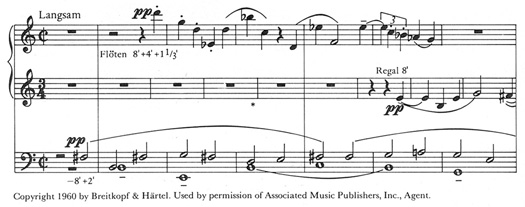
Four-voice texture is illustrated in Example 9. On the fourth half-note beat of measure 2, the alto voice leaps to g, against a leap to the f in the bass (*). The g duplicates the preceding cantus g in the soprano voice, and does give an appoggiatura impression. In measure three, the two inner parts leap to a second on the off-part of beat one (**). The b in the alto supplies part of the tertian sonority, and the a in the tenor is part of the line imitating the alto. These instances, therefore, do seem contextually justifiable. In measure five, there is another second in the inner parts, justifiable on the same basis as that in measure three. Otherwise, there are no other "exceptions" in this variation, which does include, by the way, two cases of leaps to the perfect fourth in the soprano and bass cantus firmus lines.
Ex. 9. Walter Pach, Partita canonica super "Vater unser" (1960), Var. 2, mm. 1-4.
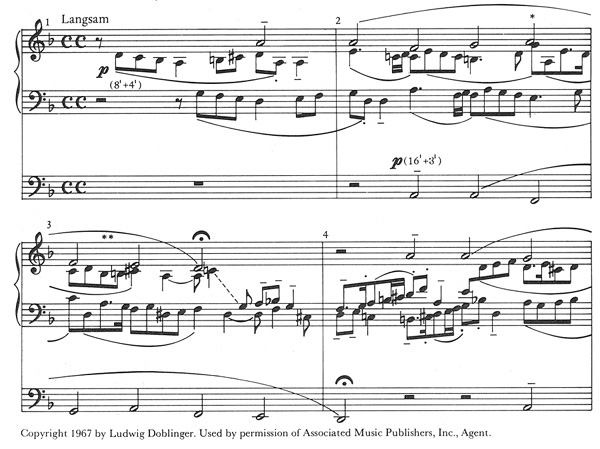
The largest number of compositions included in this study were those in four-voice texture having a cantus firmus used canonically in two voices. Three-voice texture, with a two-part canon, was also quite common. While there were not as many where the canon itself appeared in more than two voices, several interesting examples were located.5 One is given in Example 10.
Ex. 10. Horst Gehann, "Christus der uns selig macht" from Zehn kleine Choralvorspiele, mm. 1-11.
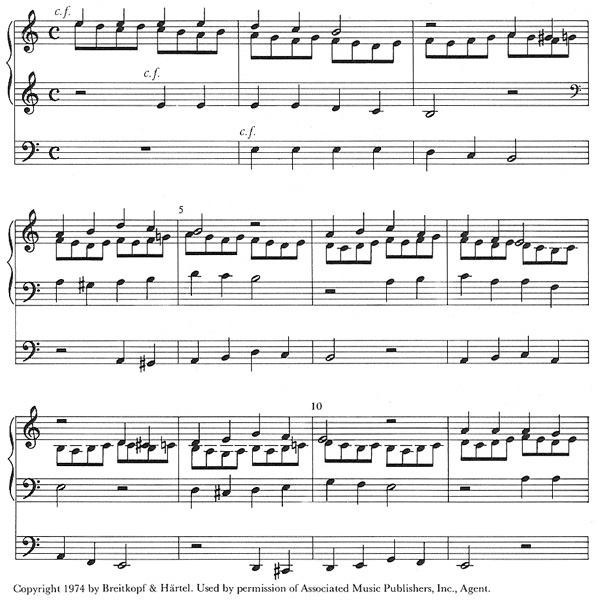
The cantus appears in the soprano, tenor, and bass voices. In this combination (canon at the octave and fifteenth after two beats and four beats) there is only one instance where there are simultaneous leaps at all. That occurs in measure seven between the soprano and tenor, and the leaps are parallel thirds, to the interval of the sixth. (This particular melodic phrase recurs in measures 16-18.) The alto voice is based on a single four-note motive, and is completely stepwise. Thus, this is a prime example of a composition where linear control falls entirely within the principle of extended preparation.
The overall aural effect, perhaps best characterized as "pandiatonic," is typical for many of the pieces in this study, although certainly a wide variety is possible, and indeed was encountered. Some compositions retain traditional tertian combinations, even including functional harmony; some contain more chromatic lines, more disjunct melodic motion, and more dissonant harmonic combinations than the example by Gehann, which nevertheless does have examples of simultaneous cross-relations. It is obviously necessary to combine other analytical information (scalar content, specific harmonic combinations, framework analysis, etc.) with that derived by using the technique suggested in this article to give a more complete story of a given work. However, for selected twentieth-century literature having a reasonably contrapuntal texture (and not limited, of course, to compositions having a canon or a cantus firmus) the analytical technique can often provide relevant insights as one considers aspects of linear and rhythmic control. In some cases it does appear that adherence to the principle of extended preparation occurs as a result of conscious linear control by a composer, but for the most part adherence to the principle probably reflects a more natural, relatively subconscious contrapuntal instinct.
One composer who has been especially prolific in organ literature which incorporates a cantus in canon is Johann Nepomuk David. Since 1932 he has produced a series of organ compositions, published in several volumes under the general title Choralwerk.6 Many of the works do make use of canon, often in more than two parts, and often in different mensural distribution, as was seen in Example 8. Accompanying voices, though not strictly canonic, are also often based closely on a part, if not all, of the cantus. Examples of two unusual cases will help illustrate the wide variety of his approach.7
Ex. 11. J.N. David, "Erhalt uns, Herr" from Choralwerk, vol. I, No. 3, Var. I.
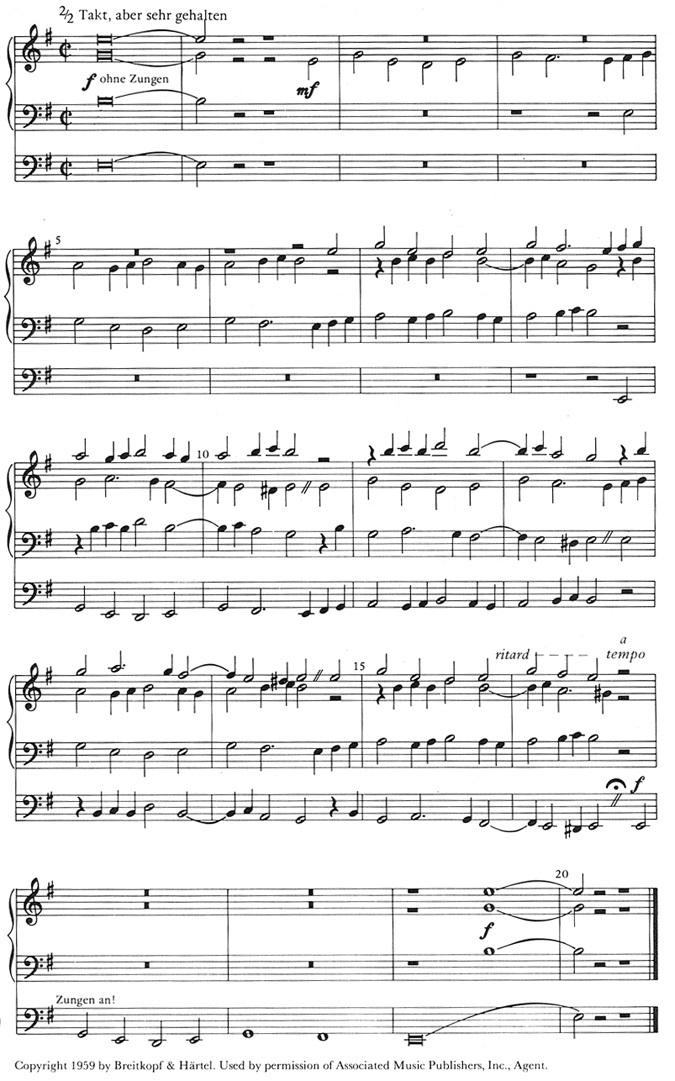
In "Erhalt uns, Herr," all four voices have the cantus firmus, which is slightly modified. The entries occur at the distance of a complete phrase, however, so the piece emerges as an example of a round! Simultaneous leaps to an octave occur on the downbeat of measures 11, 13, 15 (the "repetitions" of successive voice pairings) but there are no other simultaneous leaps, thus producing the graceful, flowing musical result that seems associated with many of these compositions.
In Example 12 the cantus, starting in the tenor voice, again contains some modifications. Once modified, though, the other three voices keep strict canonic imitation. However, the alto imitates by inversion, the bass by retrograde, and the soprano by retrograde inversion, thus simultaneously employing the four possible melodic permutations! One set of parallel octaves (in measure nine between the soprano and tenor) illustrates the relaxation of attitude toward traditional voice-leading principles, but, remarkably, there are only two instances of simultaneous leaps (measures six and fourteen, between the alto and bass) and these are to the interval of a tenth.
Ex. 12. J.N. David, "Christus der ist mein Leben" (1937), from Choralwerk, vol. VI, Var. VI.
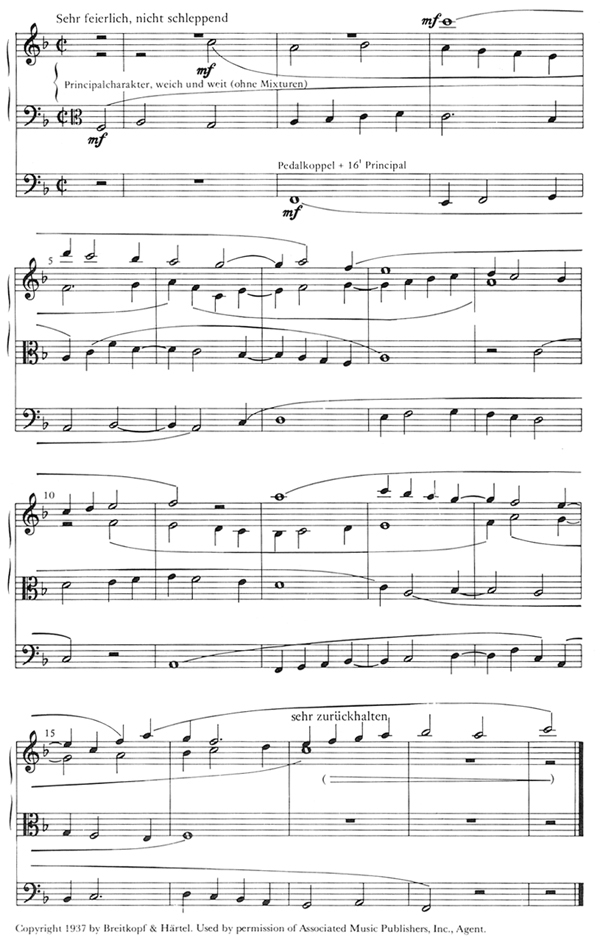
The employment of a cantus firmus in a composition seems to present an intriguing challenge in the attempt to balance elements of unity and variety. A canon contributes an element of greater unification, and it is interesting to trace the use of canon in the compositions listed in the appendix. It is also interesting to consider that while in twentieth-century compositional practice traditional uses of harmony, of non-harmonic tones, and of voice-leading principles have been generally proscribed, the principle of extended preparation is often in evidence, and provides an analytical procedure which can lend insight into the linear and rhythmic control of a polyphonic composition as well as being applicable to a student's own compositional endeavors.
APPENDIX
In the following chart, there are three sections: the first lists examples in the traditional seventeenth- or eighteenth-century style; the second, examples in nineteenth-century style; the third, examples from twentieth-century literature. Within each section, compositions are listed alphabetically by title of the cantus firmus.
The columns contain, respectively, the following items:
Column 1: Title. Column 2: Composer. Column 3: Title of source, if the composition appears in a collection, or as part of a large opus. Column 4: Publisher and date. Column 5: Identification of section, variation number, or part if the item is contained within a larger work. Column 6: The number of voices in the texture. Column 7: The number of voices having the cantus firmus in canon. Column 8: The pitch interval and time interval between the leader and follower(s) in the canon. Pitch is by number of the interval, followed by "a" for above or "b" for below. Time is by number of beats. Thus "8a,4" means imitation at the octave above, after 4 beats. The term "varied" (Var.) appears when the imitating pitch and/or time interval was not kept consistent during a composition. Cases of one change are listed as, for instance, "8a&b,4" meaning the imitation was first at the octave above, then later changed so that an upper voice was the leader and the imitation is at an octave below, each occurring after four beats. Column 9: Comments regarding special cases or techniques.
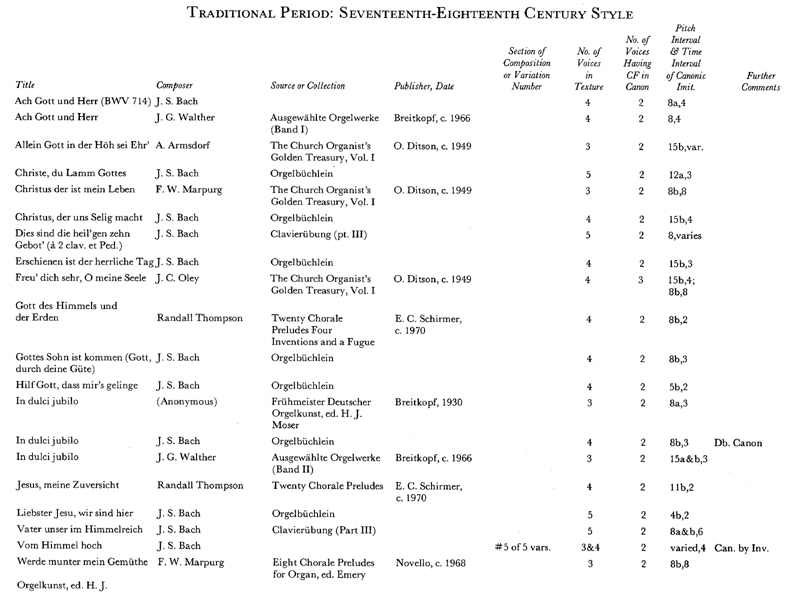
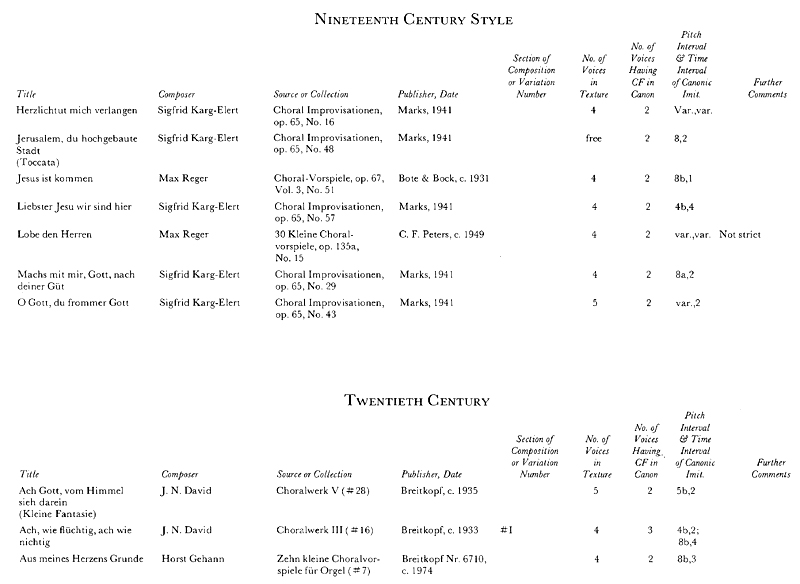
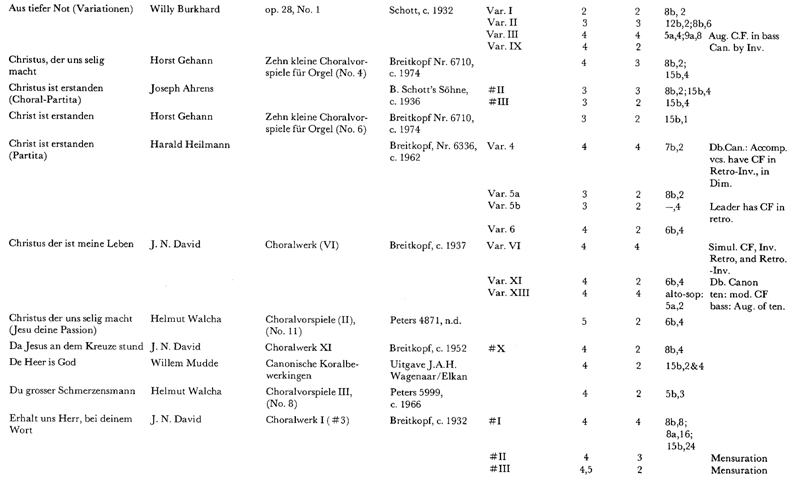
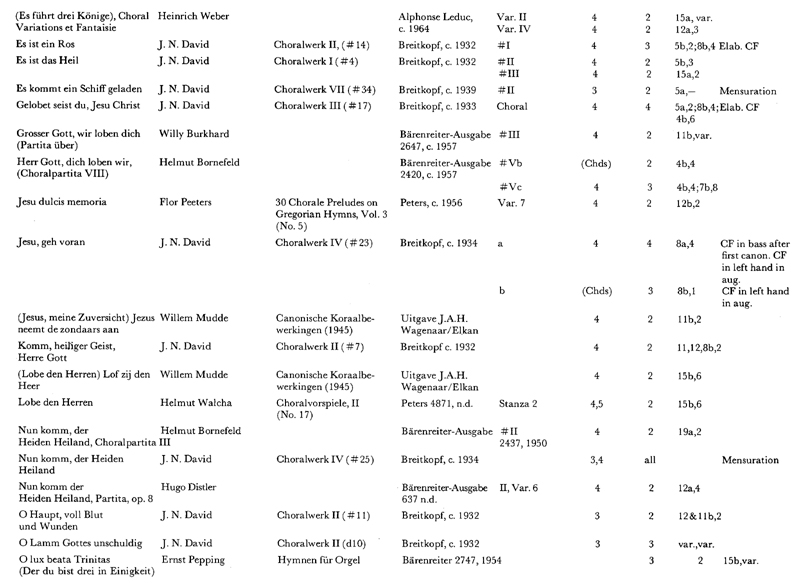
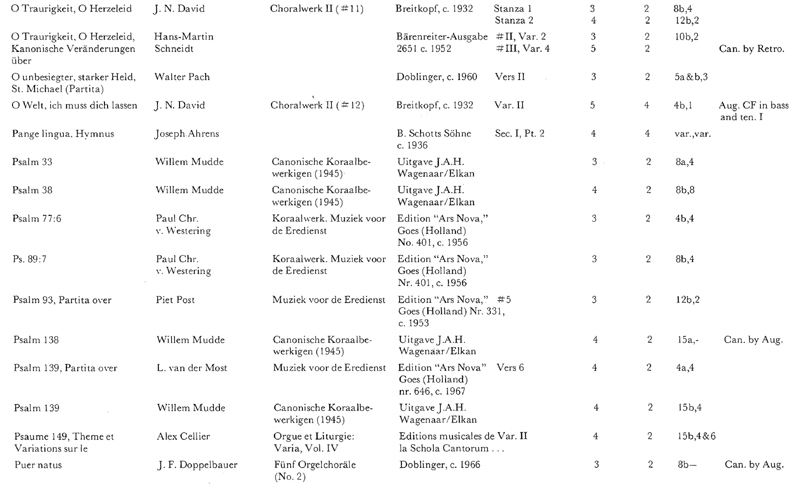
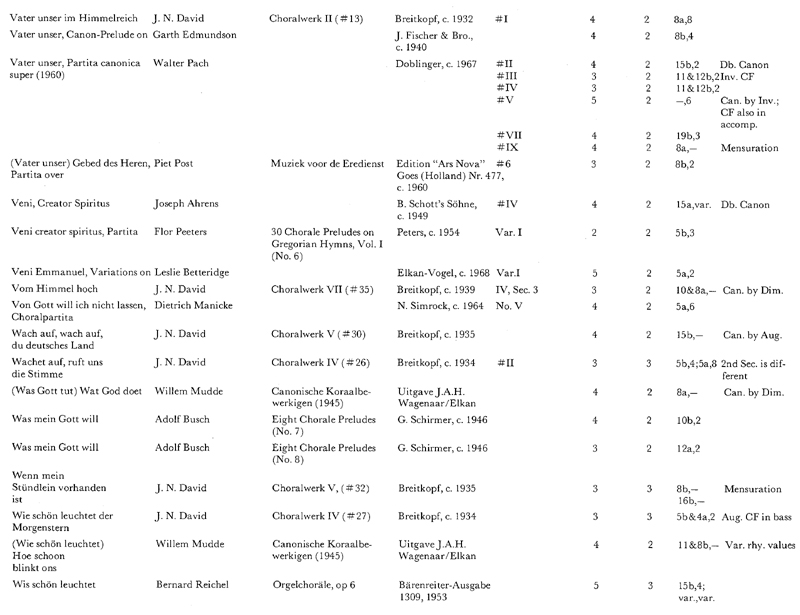
1The first note of phrases two and three are given the common modification of substituting a half-note on beat four for a whole note on beat three.
2"Simultaneous leaps" also includes a leap in one voice against a note in another voice entering after a rest, although the length of the rest and the relationship of the two notes on either side of the rest are possible modifying influences.
3Charles Warren Fox, "Modern Counterpoint: A Phenomenological Approach," Music Library Association Notes, Second Series, Vol. VI, No. 1 (December, 1948), p. 50.
4Obviously there is a great range of the amount of elaboration or embellishment of the cantus firmus that occurs in compositions. For the purposes of this study, the attempt was made to select compositions with as little embellishment as possible, but the choice was often arbitrary. The only other examples of two-voice texture (which include a canon) were variations six and eight of Partita canonica super "Vater unser in Himmelreich" by Walter Pach (Doblinger, c. 1967), but these have highly ornamented lines, employing the cantus as a framework only. They do qualify, however, as analytically acceptable examples of the principle of extended preparation. They also contain more specialized techniques: variation six starts with the lower voice having the inverted cantus, with the imitating upper voice having an inverted, augmented form of the lower voice. In measure thirteen, the voices are exchanged, creating double counterpoint at the octave. Variation eight is the melodic inversion of the respectively exchanged voices of variation six.
5In the appendix, the number of voices in the texture and the number of voices having the cantus in canon is listed for each composition.
6In the appendix, references from the first eleven volumes of Choralwerk are included.
7See also: Donald Charles Johns, Johann Nepomuk David's Choralwerk: A Study in the Evolution of a Contemporary Liturgical Organ Style, Ph.D. dissertation, Northwestern University, 1960.
